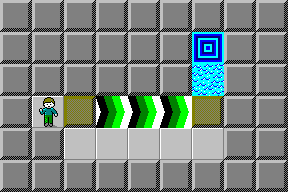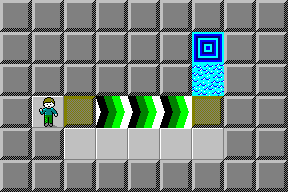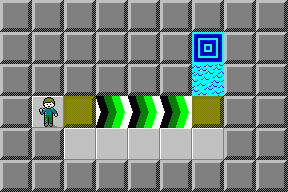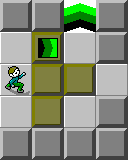Please create an account or Login! Have fun!
Ram: Difference between revisions
(added CC2 info; removed distinction between moving and stationary rams as they're the exact same mechanic) |
(changed the diagram) |
||
| Line 3: | Line 3: | ||
== MS == | == MS == | ||
In MS, when a sliding block is pushed perpendicularly and the block either is in a closed [[trap]] or is being pushed against a block-[[acting wall]], it will be removed from the [[sliplist]] and stay put, as if the block had started on this square. [[Chip]] can then push the block in any open direction. This example shows a level where | In MS, when a sliding block is pushed perpendicularly and the block either is in a closed [[trap]] or is being pushed against a block-[[acting wall]], it will be removed from the [[sliplist]] and stay put, as if the block had started on this square. [[Chip]] can then push the block in any open direction. This example shows a level where a ram has to be used to solve: | ||
[[File: | [[File:Ram.png]] | ||
In order to reach the exit Chip must push the first block right, onto the line of force floors. If Chip then continues to the end of the level and pushes the second block without ramming the first, he will die: | |||
[[File:Ram Anim Die.gif]] | |||
However if Chip before pushing the second block, pushes the first block upwards, it will ram the block against the wall and stop it from sliding. Doing this will allow Chip to safely complete the level: | |||
[[File:Ram Anim Win.gif]] | |||
=== Mouse Panel Glitch === | === Mouse Panel Glitch === | ||
Revision as of 19:30, 28 May 2021
The ram is a technique used in the MS ruleset (and, to a lesser extent, the Steam ruleset) of Chip's Challenge to stop blocks from sliding on sliding tiles. Rams are usable whenever a block is attempting to slide, whether it is moving or not.
MS
In MS, when a sliding block is pushed perpendicularly and the block either is in a closed trap or is being pushed against a block-acting wall, it will be removed from the sliplist and stay put, as if the block had started on this square. Chip can then push the block in any open direction. This example shows a level where a ram has to be used to solve:
In order to reach the exit Chip must push the first block right, onto the line of force floors. If Chip then continues to the end of the level and pushes the second block without ramming the first, he will die:
However if Chip before pushing the second block, pushes the first block upwards, it will ram the block against the wall and stop it from sliding. Doing this will allow Chip to safely complete the level:
Mouse Panel Glitch
The Mouse Panel Glitch will successfully perform a ram, but is generally harder to pull off, as mouse use lacks the precise timing of the arrow keys that would be required if the block is not sliding into obstacles. In addition, the telltale sound of Chip hitting a wall is absent whenever this glitch is used, which would make a mouse-assisted ram impossible to read in a TWS.
Applications and After the Rainstorm
Rams, along with being stratagems and safeguards, can often be used as a trade of time for safety, in such areas as Block Buster. An extremely famous ram, by contrast, is the one required to solve After the Rainstorm:
When they find this area of the level, many players will walk (UR) DRURU and be flattened every time by block 2. Chip needs two blocks in order to continue the level, so moving (DR) URDRU instead will not work as it only picks up one block. Moving -U first will stop block 2 from sliding when block 1 is moved.
The difficulty in applying this is finding it in an AVI; these do not record sound. A TWS does record sound, but in return the mouse is not recorded, such that using a mouse-assisted ram would make the solution impossible to read. Another problem which occurs in After the Rainstorm is that Chip is already moving U, such that the -U move is not as obvious to a watcher as if the previous move was something else, as Chip would physically turn. These combined factors lead to puzzlement on this level in many cases, equivalent to the public puzzlement on Two Sets of Rules and the cross-checking required to solve this in MS.
Steam
Ramming in Steam is limited to ice corners. If a block is pushed while sliding on an ice corner, it becomes stuck sliding into the 2 sides that the corner is on, and can only be removed with a hook, bowling ball, or time bomb. The push can happen at any point while the block is sliding into or on the tile, and does not have to wait for the block to be fully on the tile.



